UNLEASHED! THE NEW WORLD RALLY CAR-INSPIRED FORD FOCUS RS
Focus RS is a niche, limited-production, ultra high-performance road car which, as well as revitalizing the RS marque, has been the catalyst for a new range of high-performance Fords.
For those enthusiasts who have craved the return of Ford’s high-performance arm, Focus RS incorporates all of the hallmarks of driving pleasure, precision handling and heady performance associated with the brand – it is the ultimate road-going Focus model.
Martin Leach – President and Chief Operating Officer
Ford of Europe
- Focus RS is the WRC inspired Focus performance model.
- Balanced capabilities, including exhilarating acceleration, confident dynamics, precise steering, and assured braking efficiency, create a harmonious performance experience for the Focus RS driver.
- Focus RS accelerates from 0-100 mph (0-160 kph) in 15.5 seconds, generates braking forces in excess of 1.0g to break from 100 mph (160 kph) to a halt in just 4.1 seconds and has a top speed of 144 mph (232 kph), while its steady-state lateral acceleration of 0.94g indicates its world-class dynamic capabilities.
- Powered by a Duratec RS 2.0-litre engine with an advanced turbocharging system and oil-spray cooled pistons to achieve 65 percent more power, which peaks at 215 PS.
- Carefully engineered chassis and a Quaife torque-biasing differential combine to ensure optimal front-wheel-drive tractability.
- Proven rally sports names cement the family relationship with Ford’s WRC cars as Focus RS features components from Sparco, Garrett Technologies, O.Z. Racing, Brembo, Sachs Racing and AP Racing.
- The aggressive exterior look is inspired by the Focus WRC. Inside, it is competition-themed but with great comfort and functionality.
- Performance capabilities are true to tradition as Focus RS pioneers the return of Ford’s legendary high-performance RS marque.
- Production limited to 30 units per day in Ford’s Saarlouis Plant, Germany, with volume production starting mid-September 2002.
Push the start button and the 215-PS engine growls to life. Inspired by the Ford Focus WRC and boasting impressive performance credentials of its own, the Ford Focus RS is ready to take its place as the ultimate Focus for the street, reinvigorating the legendary RS brand across Europe.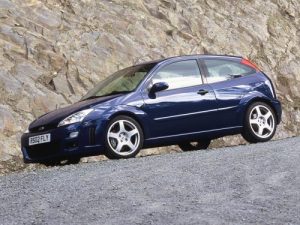
Conceived as a pure driver’s car, the new Focus RS delivers a true performance edge with a harmonious balance of exhilarating power and acceleration, confident and precise dynamics and steering capabilities, impressive braking efficiency, aggressive exterior styling, and a purposeful, driver-oriented interior.
Focus RS is the closest you can get to a road-going version of Colin McRae’s Focus World Rally Championship contender.
With authenticity in mind, the Focus RS provides the performance purist with many of the same proven and respected performance technologies used by Colin McRae, Carlos Sainz, and Markko Märtin to compete at the top of world-class rallying.
Appropriately revised and engineered for everyday use versus the more expensive and torturous exclusivity of a WRC event, the new flagship road car incorporates some of the most respected names in motorsport.
These include Sparco (seats), Garrett Technologies (turbocharger), O.Z. Racing (wheels), Brembo (brakes), Sachs Racing (dampers), Quaife (differential) and AP Racing (clutch).
Powering Focus RS is a turbocharged, 2.0-liter, Duratec RS engine derived from the 130 PS, naturally aspirated, four-cylinder Duratec engine that leads the mainstream Focus petrol range.
Duratec RS delivers peak (homologated) horsepower of 215 PS (158 kW) at 5,500 rpm, an increase of 65 percent. Torque output has been increased even more, by over 70 percent, to a peak of 310 Nm (227 lb.ft.) at 3,500 rpm.
Impressive performance statistics for the new Focus RS include:
- Acceleration from a standing start – Focus RS powers from 0 – 60 mph in 6.4 seconds (0 – 100 kph in 6.7 seconds).
- In-gear acceleration – Focus RS can accelerate from 60 – 100 mph in only 9.8 seconds in 4th gear (50 – 100 kph in 8.2 seconds).
- Top speed – Focus RS achieves a ‘V-max’ of 144 mph (232 kph).
- Braking power – Focus RS generates braking forces in excess of 1.0g, and can rapidly brake to a halt from 100 mph (160 kph) in only 93 meters or from 62 mph (100 kph) in 36 meters.
- Roadholding – Focus RS achieves a steady-state lateral acceleration of 0.94g in skidpan testing. This is remarkable as the RS is derived from a family hatchback, yet exceeds the dynamic road-holding of many renowned purpose-built sports cars.
Focus RS is fuel-economy rated, in liters per 100 kilometers (miles per gallon) at 14.2 (19.9 mpg) urban, 7.7 (36.7 mpg) extra urban and 10.1 (28 mpg) combined over the new European driving cycle. CO2 emissions are certified at 237 grams per kilometer.
Despite the performance intent and aggressive stance – its wheelbase and wide track layout are taken from the Focus WRC’s tarmac configuration – the new Focus RS features superb driving comfort and practicality for everyday driving and remains well mannered and tractable around town.
A dual personality, which offers uncompromised functionality, comfort, and dependability alongside a high-performance capability for spirited driving, is the key to the character of this contemporary interpretation of the Ford RS brand.
Ford assembled a handpicked team of around 60 specialist engineers to create the new Focus RS.
Many of them had already played key roles in the development of the Ford Focus, which debuted in 1998, was voted European Car of the Year 1999 and is still acclaimed by many as the benchmark in its class for dynamic capabilities and driving quality.
Since its launch, sales of the Focus have increased year on year, with 483.000 units in 1999, 536.000 units in 2000 and 558.000 units in 2001.
In 2002 the Focus was recognized by the TüV organization as the German car industry leader in reliability for cars between one and three years old.
The team’s collective and intimate knowledge of the Focus was crucial in enabling them to build on its array of strengths and produce an equally balanced performance variant.
The RS development team has been given the time it needed to prove out the robustness and dependability of the performance package – such was the determination of the project’s backer, Martin Leach (then Ford’s Vice President of European Product Development), to get it right.
The decision was taken to put the Focus RS through the same rigorous testing program to which Ford’s higher volume, mainstream production cars are subjected.
Through this testing regimen, Focus RS has been turned into a harmonious performance package with dependability and reliability to match.
“We’ve clearly understood the feeling of urgency among performance enthusiasts to get their hands on the Focus RS,” said Mike Kilpin, chief program engineer.
“The imminent rekindling of the RS brand created tremendous excitement and expectation, but we still believe that the right thing to do was not to rush this car to market. We’re ready now, and proud of the end result — Focus RS can now speak for itself.”
Even with its specialized engineering, the new Focus RS was designed for assembly alongside other Focus models at the Saarlouis Assembly Plant in Germany where Ford has pioneered its flexible manufacturing process.
Its Duratec RS engine is manufactured at the Bridgend (Wales) Engine Plant in the United Kingdom.
Specialist engineering facilities are integrated with normal production processes at both plant locations. Production capacity is limited to 30 units a day.
Rejuvenating the RS Brand
Its performance technology and exclusivity make Focus RS the ideal vanguard to resurrect the Blue Oval’s legendary RS performance brand.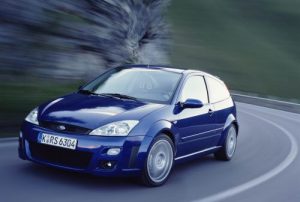
Starting with the Escort RS1600 back in 1969, RS itself would become synonymous with “performance” as Ford established a line of more than 20 RS-badged derivatives in the Seventies, Eighties and early Nineties, including the Sierra RS Cosworth, the Ford RS200, and the Escort RS Cosworth.
Originally unveiled as a concept car, the new Focus RS heralded a new approach to performance cars at Ford of Europe.
The Company has committed to an aggressive performance derivative initiative as part of its product-led European transformation strategy.
The contemporary approach to the RS brand is to create derivatives aimed at performance purists, while the more accessible ST – Sport Technologies – brand will appeal to a broader range of enthusiasts. (Ford introduced a Focus ST model – the ST170 – earlier this year.)
The company also has rejuvenated its Special Vehicle Engineering (SVE) department, charged with taking the performance strategy forward, and led by Jost Capito, who joined Ford in October 2001 and was previously Chief Operating Officer at Swiss-based Formula 1 team Sauber Petronas.
Focus RS Technical Story in Detail
The Focus RS story is not simply about the addition of a powerful engine or turbocharger. Instead, Focus RS has been engineered to deliver enhanced performance in every key attribute important to the performance-oriented driver.
The result is a harmonious set of attributes that makes the Focus RS driving experience intuitive and rewarding.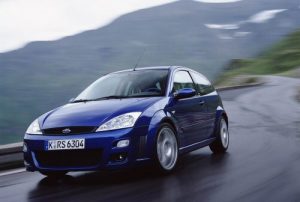
The engineering excellence of the standard Focus model would pay off for the RS development team in many ways.
From the strength of its body structure to the acknowledged capabilities of its chassis systems, Focus was clearly well suited to higher performance potential.
“We knew the huge potential in the Focus,” said RS program supervisor Andrew Mottram, an original member of the Focus product development team.
“We were able to concentrate our efforts on the vehicle attributes that required honing in order to produce a vehicle which would deliver the levels of engineering excellence, design and driving dynamics that are fundamental to the RS brand.”
The RS development team was also confident that it could capitalize on the inherent dependability and reliability of the Focus range in creating this performance derivative.
The Focus was recently named the most reliable vehicle among one- to three-year-old cars by the respected German testing organization, TüV.
Up to 70 percent of the basic components of the vehicle has been updated, re-engineered or completely redesigned to assure the same levels of robustness, quality and dependability as the standard Focus model, despite the advanced performance capabilities of the Focus RS.
The Focus RS project was remarkable for the involvement of technical contributions from Ford’s advanced vehicle engineering and the Ford Rallyesport team. The flow of technical information between Ford and its motorsport experts was central to the engineering effort.
Chassis
A finely honed and capable chassis is a key aspect of the Focus RS driving experience. Focus RS has been engineered to provide a predictably progressive and linear response to the driver.
Every facet of the chassis system has been optimized for this ultimate Focus variant’s performance capabilities.
The Focus RS engineering team began with its extensive knowledge of the standard Focus, whose Control Blade independent rear suspension set new benchmarks in its segment and continues to differentiate Focus’s driving quality from its competitors.
A series of unique modifications were then engineered specially for the dynamic attributes of the Focus RS.
For a bold and sure-footed stance, the wheel track was widened to match the tarmac specification Focus WRCs of Colin McRae, Carlos Sainz and Markko Märtin in the FIA World Rally Championship.
Measured at the center-line of the front wheels the track has been widened by 65mm compared with the Focus 2.0. Measured at the outer surface of the 8-inch wide wheels the track is 95mm wider.
This significantly wider track further enhances the confidence Focus RS instills in its driver.
Key elements of the front suspension have been updated to complement the greater performance attributes of the Focus RS.
These include new hub assemblies to accommodate tougher, larger-diameter driveshafts that transmit the Duratec RS engine’s 310 Nm of torque to the drive wheels.
Driveshaft pairs have been optimized for equal stiffness, part of a comprehensive engineering approach toward maintaining optimal traction and minimizing torque-steer in this powerful, front-wheel-drive vehicle.
The suspension system plays a key, traction-enhancing role, featuring revised geometry that enhances wheel kinematics in cornering and complements the custom Quaife torque-biasing differential. The suspension also results in a negative camber configuration that aids lateral stability.
Although the 225/40R/18 tires increase the static rolling radius (from 280 to 325mm) of the wheels the ground clearance is unchanged, avoiding any compromise in vehicle functionality in this respect. This is not the case with many sporty aftermarket kits.
The new geometry is the result of a series of engineering modifications:
- The 25mm shorter springs and matched Sachs Racing dampers have been fitted to provide superior body control and handling. Despite the shorter suspension travel the team has managed to maintain acceptable ride quality and comfort without compromising the handling precision and control of the Focus RS.
- The 18mm anti-roll bar diameter is actually thinner than on the Focus 2.0 (21mm) and thus helps to maximize traction control, but combined with the stiffer suspension the roll rate is appropriate for a sporty car like the Focus RS.
- O.Z. Racing wheels, in an 8 x 18-inch, five-spoke configuration patterned after that of the Focus WRC, are robust, lightweight and imposing.
- Bespoke, 18-inch Michelin low-profile tires give Focus RS a wide footprint on the road.
Together, these modifications affect a lower roll center that facilitates improved rebound travel for the front wheels. This helps to ensure optimal adhesion and traction during cornering.
Strengthened front A-arms locate the wheel hubs. The dual, compliance-optimized bushings of the standard Focus model have been replaced with tuned hydro-bushes, another part of Focus RS’s sophisticated approach to optimizing high-performance.
The hydro-bushes, along with revised top-mounts, help to ensure a smooth, on-center steering feel for the driver and minimized transmitted judder from the wide tires into the steering system.
Additionally, engineers have fitted a strengthened front cross-member and a stronger roll restrictor – part of the Focus torque-roll-axis engine mounting system – a refinement measure designed to resist twist effects of the higher torque levels of the Duratec RS engine.
At the rear, the Focus Control Blade independent suspension also features larger spindles to accommodate larger wheel bearings, necessary for the increased loads from the bigger wheels and tires.
Sachs Racing dampers, mated with stiffer springs and firmer bushings, customize the Control Blade system’s capabilities for the demands of the RS model.
The rear anti-roll bar link was also redesigned for improved roll stiffness.
Unique Wheels and Tyres
A key ingredient of the dynamic qualities of the Focus RS is its unique wheel and tire specification, ensuring extraordinary grip, superior traction, and impressive stopping power.
The custom, 18-inch O.Z. Racing wheels are manufactured in light aluminum alloy in a design faithful to the magnesium wheels used in the world rally cars.
The open-five-spoke, 8-inch-wide design provides motorsport-proven robustness without an unsprung-weight penalty.
Low-profile Michelin Pilot Sport 225/40R/18 tires were developed specifically for the Focus RS. These bespoke performance tires feature a unique compound and tailored architecture for their high-performance application.
Dedicated tire testing has been an important and continual process during the development of Focus RS. Ford engineers worked with Michelin personnel to achieve maximum grip combined with superior ride and handling – not just in the dry but also in the wet.
In combination with the specially tuned suspension, the low-profile Michelin Pilot Sports contribute to a ‘harder but not harsh’ ride quality that assures everyday driving comfort with impressive and precise dynamic capabilities when driven hard.
Approaching the limit, the Focus RS driver receives clear and progressive feedback from the tires.
“In developing the chassis, we devoted extensive attention to ensuring precise and predictable dynamic behavior,” explained Kilpin.
“We worked hard to deliver progressive linearity approaching the limits of adhesion, without any nasty surprises that may catch drivers unaware in some performance cars.”
Steering Precision
Building on the driving quality of the standard Focus, the new Focus RS provides the performance purist with highly precise and responsive steering as part of its balanced set of capabilities.
The Focus RS steering system provides the driver with a strong sense of controllability while communicating clear feedback when approaching the limits of adhesion.
RS engineers strove to achieve a high degree of precision and linear progression in the responsiveness of the steering system without compromising the functionality for everyday driving maneuvers, such as parking.
Focus RS maintains the same turning circle as the Focus, despite its larger, wider performance tires.
The Focus RS driver has the benefit of a bespoke leather-wrapped steering wheel that contributes to an impressive feeling of steering control, stability, and connectivity.
A falling-flow power steering pump assures easy steering effort at low speed and excellent steering feel, on-center responsiveness and agility at a higher speed.
Focus RS’s steering qualities have been accomplished through subtle revisions aimed at optimizing compliance and friction levels. These include revised mount bushings.
Braking Power
Focus RS gives its driver the confidence of a strong braking system to match its acceleration, speed and handling capabilities.
Brembo-equipped, the Focus RS generates braking forces exceeding 1.0 g, achieving stopping distances that rival those of sports cars.
But the story of Focus RS’s braking power is more than just big brakes. The Focus RS chassis plays a key role in braking performance.
The anti-lift characteristics of the rear suspension geometry combine with optimized brake load distribution to stop Focus RS with front-rear balance and poise.
This reduces pitching under braking, makes the brakes highly effective and gives the driver reassuring, progressive feedback.
The front braking system includes massive Brembo four-piston (twin-opposed) calipers and 325 mm ventilated discs.
The Brembo calipers are clearly visible behind the O.Z. Racing wheels, giving Focus RS a purposeful attitude to match its performance capabilities.
The rear brakes are solid 280 mm discs with conventional two-piston calipers.
The braking system gives Focus RS impressive stopping power. It masters a 62 mph (100 kph) -to-zero braking test in just 36 meters. More importantly for a performance car, Focus RS can halt from 100 mph (160 kph) in 4.1 seconds.
Under wet braking conditions, Focus RS maintains impressive grip levels. Only under severe applications is intervention required from the custom-configured Anti-lock Braking System (ABS).
The latest-generation ABS system, featuring specially modified software for the RS performance application’s higher grip levels, assures a sympathetic intervention strategy geared to the style of the enthusiast driver.
Duratec RS Power
The very heart of the invigorating performance experience of the Focus RS is its powerful new 215-PS Duratec RS engine, which traces its roots to the Focus WRC engine design.
With an air-to-water air charge intercooler, a water-cooled turbocharger and oil-spray cooled pistons, it boosts the four-cylinder engine’s output into a genuine high-performance territory.
The uprated engine delivers 65 percent more horsepower – 215 PS at 5,500 rpm –than the mainstream 2.0-litre Duratec engine of the Focus family.
The turbocharged engine also boosts available torque by 75 percent to a peak of 310 Nm at 3,500 rpm.
This heady combination gives Focus RS its punchy throttle response, exhilarating acceleration, and impressive top-speed potential.
A custom-built turbocharger, the Garrett GT 2560LS, delivers the boost. It is Garrett’s first petrol engine turbocharger application to use stainless steel for the turbine housing.
The turbocharger size has been optimized to give the best possible balance between high power and good transient response.
Its hardened stainless-steel turbine housing material can better withstand exhaust temperatures of up to 960º C, which the Duratec RS engine can generate.
A boost recirculation valve is used in the intake system to prevent an undesirable phenomenon known as ‘compressor surge’ on deceleration and to reduce turbo lag following a gear change.
When the driver momentarily lifts off the throttle a conventional turbo produces excessive boost and the control system acts to open the exhaust wastegate and slow the spinning turbo.
Turbo lag is largely caused by the time taken for the turbo to accelerate up to its optimum speed again.
The recirculation valve opens when the throttle is lifted, re-directing the boosted air back into the compressor inlet.
This avoids the excessive pressure build-up and the wastegate system keeps the turbo spinning fast.
The benefit comes when the throttle is opened again and full boost is available almost instantly.
The recirculation valve is technically superior to the often-used ‘dump’ valve as it allows the engine management system to maintain the optimum fuelling.
The EEC-V Powertrain Control Module (PCM) has several novel features to optimize the performance of the engine.
It senses which gear is being used and adopts different torque curves in the lower gears to optimize traction and prevent overstressing of the transmission.
It also monitors the temperature of the air entering the engine and modifies the boost pressure to deliver consistent power and torque levels for all ambient conditions.
There is also a measure designed into the unit to protect against potential engine failures from after-market ‘chip-tuning’ power modifications.
The PCM determines the required boost level, from the driver throttle input and other engine sensors, thereafter constantly monitoring the boost and adjusting the wastegate until the target pressure is reached.
During this control process, the PCM is learning the wastegate characteristics, adapting to the effects of wear or manufacturing tolerances within the turbocharger.
Turbocharger longevity and durability are protected by a water-cooled bearing housing, which prevents thermal degradation of the oil within the bearings when the engine is switched off whilst hot.
Vital to any turbocharged petrol engine is an efficient intercooler. This heat exchanger takes excess heat out of the compressed air from the turbocharger compressor, cooling it down and increasing its density as much as possible.
The RS intercooler will deliver air temperatures typically of 40-60º C at peak power.
The ‘no compromise’ design philosophy of the Focus RS dictated the specification of an air-to-water intercooler.
This approach also benefits the under bonnet packaging in that the charge cooler now occupies the space vacated by the standard air cleaner.
This helps to minimize the intake volume between the turbocharger compressor and the engine, in order to optimize boost response.
Using water as the cooling medium results in higher thermal inertia in the system, giving lower charge temperatures and maximum performance during transient operation, such as hard accelerations.
The water circuit for the intercooler is entirely separate from the engine cooling system and has its own radiator placed in the airstream ahead of the engine-cooling radiator.
The large lower grille in the front bumper positions the intercooler radiator directly in the airflow for maximum cooling effect.
To achieve the 215-PS power level, a very free flowing exhaust was imperative. However, this requirement has to be balanced against the need to reduce emissions with a catalyst system.
The Focus RS meets these conflicting demands with a bespoke system that features a fast light-off catalyst close to the turbocharger, a larger main catalyst, a low-loss silencer design, and a titanium-colored finisher.
Vital lessons learned from several years of the Focus WRC program indicated at an early stage of development that a higher-flow-rate water pump would be required for Focus RS.
Consequently, a completely new water pump was designed and developed. With a power increase of 65 percent, there is inevitably a similar rise in the heat generated by the engine.
Greater coolant flows are required to remove this heat and ensure the engine does not exceed its safe working temperature limits.
Focus RS also features a high-flow fuel pump and injector designs, also WRC inspired.
New forged connecting rods and pistons have been developed to cope with the increased cylinder pressures.
In addition, the piston pin design was changed from a press fit to a fully floating design.
Forged rather than cast, the aluminum piston is based on that used in the WRC engines for added durability. The internal compression ratio is reduced from the standard 10:1 to 8:1.
Sodium-filled exhaust valves are employed in the Duratec’s aluminum cylinder head to increase the transfer of heat away from the valve head, improving component life and reducing the risk of detonation.
The valve springs are also tuned to increase the closing forces, essential to prevent the exhaust valves from leaking exhaust gases back into the combustion chamber under back-pressure.
Conditions of high exhaust manifold pressure occur when the turbocharger is delivering high boost pressures, such as at peak power conditions.
To meet the demanding quality and consistency targets expected of a mainstream product, considerable engineering effort has gone into ensuring the engine can be assembled in a high-volume production facility, where continual quality checks are routine.
Also, at the end of its assembly, every Duratec RS engine undergoes a hot test to assure the quality of the finished engine.
“Engineering an all-new powertrain with a 65 percent power increase was the biggest challenge of the entire RS program”, said Dr. Georg Heuser, Focus RS powertrain manager.
“Ford’s strict standards for quality and engineering excellence were applied rigorously to achieve excellent levels of driveability, responsiveness, refinement, and performance.
I believe this painstaking effort will set Focus RS apart from its major competitors.”
Unique Transmission with Torque-biasing Differential
Focus RS has been comprehensively engineered to transform high levels of torque into effective traction at the drive wheels.
Its uprated 5-speed MTX75 transmission plays a key role in this strategy while contributing significantly to the performance feel of the vehicle.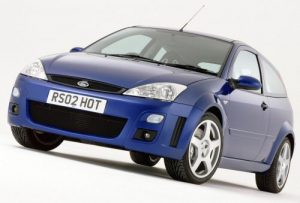
At its heart is a race-bred Quaife Automatic Torque-Biasing (ATB) differential.
Combined with a chassis developed to use torque effectively, the Quaife differential helps Focus RS accelerate without provoking wheel spin in dry conditions.
When the throttle is heavily depressed from standstill the car accelerates in a straight line.
In the wet, the wheels may spin but the torque-biasing capability ensures that the car remains straight, making Focus RS a very forgiving and relatively easy car to drive despite its high-torque output through the front wheels.
Unlike the standard plate-type differential, the custom-designed Quaife differential uses worm gears to transfer seamlessly the torque between the two wheels according to the level of traction available.
This ensures that it never locks up like a plate-type differential, delivering better traction for the vehicle at high power.
“With a standard differential, you have to lose traction before you regain it,” explained Kilpin.
“The more sophisticated Quaife technology, which we have customized especially for this application, gives the Focus RS driver a big advantage when it comes to keeping the power on the ground and reducing the potential for understeer.”
Previous locking type differentials tended to tug at the steering wheel and produce more understeer, and under hard acceleration, there was always the tendency for it to pull the wheels one way or the other.
Torque also is electronically limited in first, second and reverse gears to protect the transmission and aid the driving experience by eliminating any vicious snap of torque, thus providing an inherent degree of traction control.
The gearbox incorporates a unique set of close ratio gears developed to provide optimum performance and animated driving quality.
Evenly spaced, the gearing provides the Focus RS driver with punchy acceleration, taking full advantage of the turbocharged power of the Duratec RS engine. The gear cogs are shot-peened for enhanced robustness.
“Feedback from the Focus RS WRC drivers throughout the program was crucial in developing the ‘rally car for the road’ feel,” said Kilpin.
“For the transmission, that dictated a choice of ratios biased towards in-gear acceleration.”
To transmit engine power into the gearbox, Ford RS engineers specified another no-compromise piece of race-bred equipment, a heavily uprated AP Racing clutch.
Shift feel, another important attribute for the performance purist, was the focal point of extensive attention to detail by the Focus RS development team.
Focus RS’s Sparco solid aluminum gear selector features a short-throw shifter mechanism. It ensures an extremely positive shift feel and reduced gear lever movement, enhancing the performance driver’s feeling of connectivity with the car.
Rally-Bred Exterior
With its purposeful appearance, the Ford Focus RS is immediately recognizable as a serious performance vehicle.
It takes its function-driven design cues directly from a world-class motorsport competitor, the Ford Focus WRC.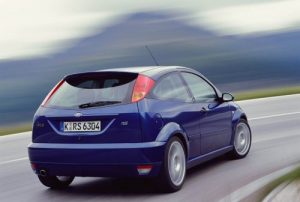
The shape of the Focus RS has been painstakingly developed and aerodynamically honed to create a car worthy of the RS name.
Rather than overcomplicating the styling, Ford stylists have chosen to detail forms with crisp accent lines, combining sophistication with performance engineering elements.
“Focus RS sets itself apart visually from the competition by communicating a clean, mature message, that is delivered without resort to frivolous extra forms and details,” said Chris Bird, Design Director, Ford of Europe.
While reflecting design cues from the Focus WRC, Bird and his team worked to assure that the new Focus RS would have the robustness and dependability that comes from more production-feasible materials than those found in an all-out competition vehicle like a world rally car.
The result of these efforts with materials specification is a performance vehicle that meets all of Ford’s production-car safety and quality standards.
Only the bonnet, tailgate, doors and roof panel remain unchanged from the standard Focus.
Every other exterior panel of the Focus RS body is unique, inspired by the stance and attitude of the Focus WRC.
New sheet metal for the front and rear quarter panels has been designed with wide wheel arch extensions to complement the wider track of the Focus RS, and the front and rear bumpers and sill moldings are unique.
The body structure begins its life like every other Focus at Ford’s Saarlouis Assembly Plant in Germany.
It is diverted from the standard assembly process to allow a special engineering center to install the crucial body modifications, especially the custom-shaped rear quarter panels, which are welded in place of the standard Focus items.
Before rejoining the standard assembly process to undergo final metal finishing and the full production paint process, in which it gets its exclusive blue sheen, Focus RS is fitted with durable reinforced polypropylene molded front and rear bumpers, side sills and a rear spoiler mounted on the tailgate.
The unique, shaped bumpers provide a distinctive look of performance with road-car aerodynamic functionality.
The rally version of the Focus is designed primarily to produce extensive downforce at speeds not much more than 100 mph. More downforce provides rally drivers with high levels of grip at the expense of top-end speed.
In Focus RS, the emphasis is much more on higher speed stability. As a result, the car has been extensively wind tunnel tested using data gathered from the WRC programme.
The result of the revised exterior shape with the deeper front grille and wider footprint tires is a drag coefficient of 0.365.
Viewed head-on, Focus RS incorporates grille apertures similar to the WRC car, but with added Hella fog lights.
Twin slots in front of each wheel arch aid in under bonnet cooling and the radiators for engine cooling and turbocharger intercooling are positioned behind the large central grille opening.
For use on the Focus RS, the headlamp from the Focus range has been modified to remove the integral turn indicator in favor of bumper-mounted indicator lamps, another Focus WRC-inspired touch.
Turn indicators are fitted with blue bulbs that complement the Imperial Blue Focus RS exterior color scheme when they are not illuminated. These special bulbs become amber-colored when illuminated.
Focus RS remains easy to drive despite the major external revisions, retaining highly practical ramp angles front and rear for negotiating normal driving hazards such as speed humps or angled driveways.
Other performance equipment fitted in specialist centers includes the Michelin Pilot Sport performance tires, mated to the 18-inch O.Z. Racing wheels.
Once complete, each vehicle’s suspension is minutely inspected to ensure that Focus RS’s carefully engineered geometry and optimal track settings are in compliance.
It is this intensive specialist attention that mirrors Focus RS’s motorsport heritage.
Finally, each car goes on a dedicated rolling-road test before its sign-off as a Focus RS.
Competition-inspired Interior
To match its impressive all-around, competition-inspired performance, Focus RS features an interior with even more functional, motorsport-derived equipment.
The Focus RS performance driver benefits from WRC-derived elements carefully designed with simplicity, style, quality, and durability very much in mind.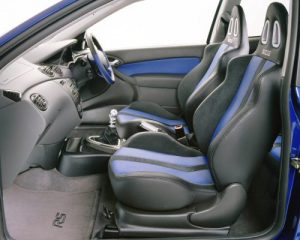
Just three surface colors are featured throughout – black, blue and silver – punctuated by special touches that include carbon-fibre.
“The metallic elements are functional, the leather is high quality, the Alcantara is purposeful and the carbon fiber is real,” said Ford of Europe Design Director Chris Bird. “There is nothing fake about the interior of Focus RS.”
The most striking of all the interior appointments are the race-inspired seats, developed in conjunction with Sparco.
Extensively track-tested to deliver just the right combination of comfort and impressive grip for spirited driving, the Sparco seats reflect the attention to quality that has permeated every aspect of this top Focus performance vehicle.
“We spent countless hours test-driving the RS seats,” Bird said. “They are not just a pretty package. Professional drivers took these seats through their paces, changing fabrics, foam densities, support structures, and even logo location.”
The seats are stitched in black leather with dramatic dual stripes in blue leather, plus carefully positioned panels of contrasting black Alcantara cushion and backrest inserts which provide extra grip, enhancing driver and passenger seat location under hard cornering.
Bold Sparco branding on the headrests and discreet RS logos embossed on the seat cushions complete the heritage link for performance purists.
The Sparco seat design also features integrated harness slots within the headrests, just like the full racing version, while also providing comfort and ease of use for everyday driving. The driver’s seat is four-way adjustable.
Sparco branding adorns the backrest of the rear seat, which is produced in matching hide with feature lines stitched in to identify the separate seat positions.
The 60-40 split seatback design ensures that Focus RS retains all of the loading flexibility of its sibling models.
Rounding off the quality interior theme are distinctive carpet mats with subtle RS branding.
Rally-inspired details continue in the unique Focus RS instrumentation design, most noticeably with the bold “blue band” graphic scheme of the analog speedometer and tachometer dials. Each gauge features a backlit blue band on a black field, in a style closely matched to the rally car.
This exclusive instrument cluster features functionally segregated and individually framed gauges, and performance purists will also note other unique functional differences from the rest of the Focus family. These include:
- A turbo boost gauge, which occupies a prime position to the left of the tachometer. It is fitted in place of the standard water temperature gauge, which is replaced by a warning light.
- A change-up light, another feature taken from the rally car, has been added within the rev counter to prompt the driver visually to shift gear.
The steering wheel, finished in blue/black leather with an oversteer indicator stitched in, has been specially manufactured for Focus RS.
Focus RS’s fascia and door panels are produced in Midnight black with blue leather inserts for the doors and rear quarters.
Neat metal interior elements geared to the performance driver include an aluminum handbrake lever, short-throw shifter knob and drilled-style aluminum pedals with rubber inserts, all specified from performance specialist Sparco.
Electro-plated satin aluminum effect door handles and stainless steel scuff plates with RS lettering augment the metal theme.
The eye is drawn to another motorsport detail as the driver prepares to start the powerful intercooled turbo Duratec RS engine. It is the functional start button in Focus RS’s carbon-fiber center console.
“The center console was changed not just for aesthetic purposes alone,” Bird said.
“The new short-throw shifter has different packaging requirements that the base console couldn’t accommodate. This also gave us the chance to integrate carbon elements and the start button.”
The carbon-fiber center console also serves as an indication of the exclusivity of the new Focus RS.
Each vehicle is individually numbered on a special aluminum plate located by the start button on the console unit.
Despite the focus on performance detail in its interior, the new Focus RS doesn’t overlook creature comforts and convenience. Focus RS retains the highly practical interior layout of the standard Focus and boasts power-assisted windows, power steering, air conditioning, and Ford’s in-dash six-CD changer as part of its long list of standard features.
FASTEST FOCUS IS BBC ‘TOP GEAR’ CAR OF THE YEAR
BRENTWOOD, 28 February 2003 – The fastest ever production Ford, the scorching Ford Focus RS, is first across the line in BBC ‘Top Gear’ magazine’s 2003 Car of the Year awards, taking both ‘Best Driver’s Car’ and overall ‘Car of the Year’ trophies.
The car that returned the RS performance brand to the Ford stable beat the competition hands down, with the Top Gear team saying: “Whether carving across a B-road, tackling the test track or raging around a race track, the Focus RS fizzes with a frenzied excitement no rival can come close to capturing… We jumped out of it, grinning broadly and knew we’d found a winner.”
Also one of the fastest selling Ford’s ever, Ford Focus RS is now officially sold out in the UK, with all the first year’s production of 2000 cars now taken up by enthusiastic customers.
Ford Focus brand manager, Cathy Davies, said: “We’ve been delighted by the reception for Focus RS, which reflects our own enthusiasm and belief in the return of the RS brand.
This award, together with the news our first year’s production is now sold out, truly vindicates our passion for the RS.”
Factory Specifications
Engine: 2.0-liter 16V turbocharged 4 cyl Duratec RS
Transmission: 5-speed, with revised gear ratios, Quaife automatic torque biasing differential, uprated drive shafts. New sports short-throw shifter mechanism.
Interior: Sparco race-style leather/Alcantara trimmed bucket seats in black/blue. Focus rear bench seat trimmed to match. Black/blue leather steering wheel with stitched-in oversteer indicator. Sparco aluminum handbrake, gear knob, pedals. Carbon-fibre cen
Horsepower: 212 bhp @ 5500 rpm
Torque: 229 lb-ft @ 3500 rpm
0-60 mph: 6.4 sec
Top Speed: 144 mph
Fuel Eff: 20/37 mpg
Fuel Cap: 55 liters
Brakes: Brembo 4-pot, twin-opposed piston callipers, and 325 mm ventilated discs / Two pot calipers and 280 mm solid discs w/ABS
Tires: Michelin 225/40R/18 Pilot Sport low profile tires
Wheels: Unique O.Z. alloy 18 x 8inch rims with bespoke
Drive Type: FWD
Suspension: MacPherson strut / multi-link
Steering: Rack-and-pinion with power assistance, 2.9 turns lock-to-lock
(Original post from April 14, 2003)
Copyright © Ford
Dearborn, Michigan, U.S.A
If you are about to change the oil of your Ford Focus RS and you are still wondering which are the best synthetic engine oils on the market, check out our comparison here and for the top synthetic oil filters, here is our complete guide.
We have also reviewed the best car battery for hot and cold weather that is also suitable for most of the Ford models. Read the complete review here.

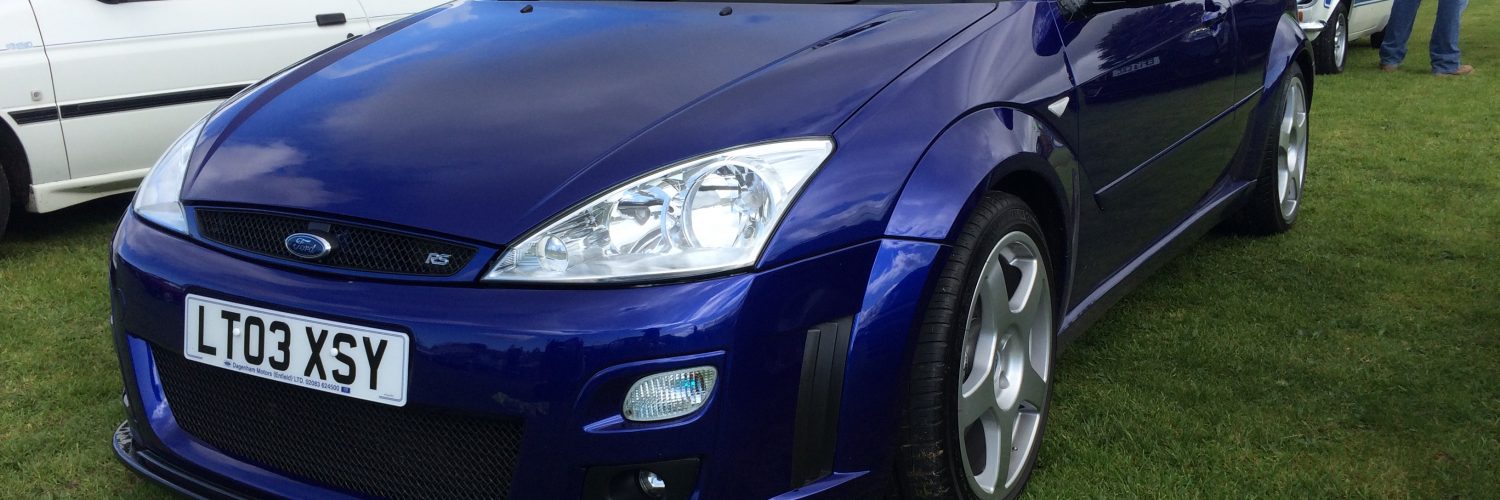
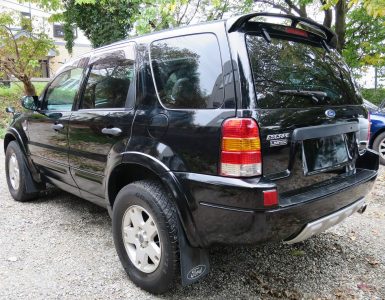
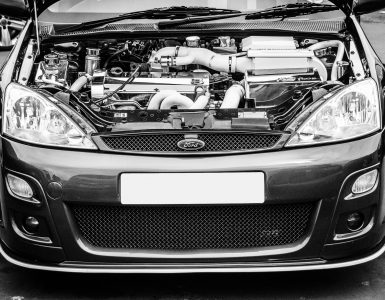
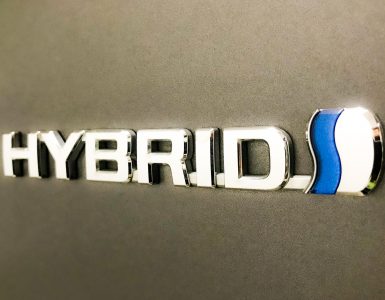
















Add comment